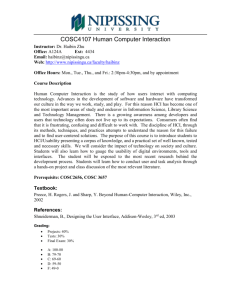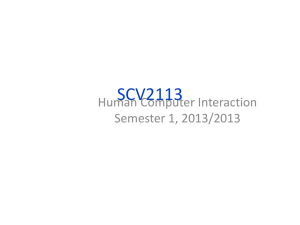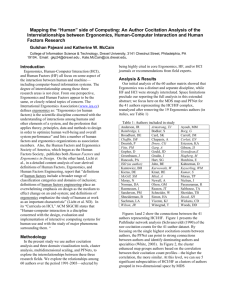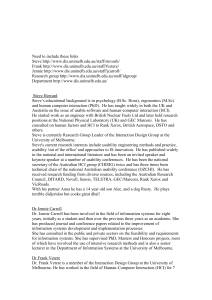HCI
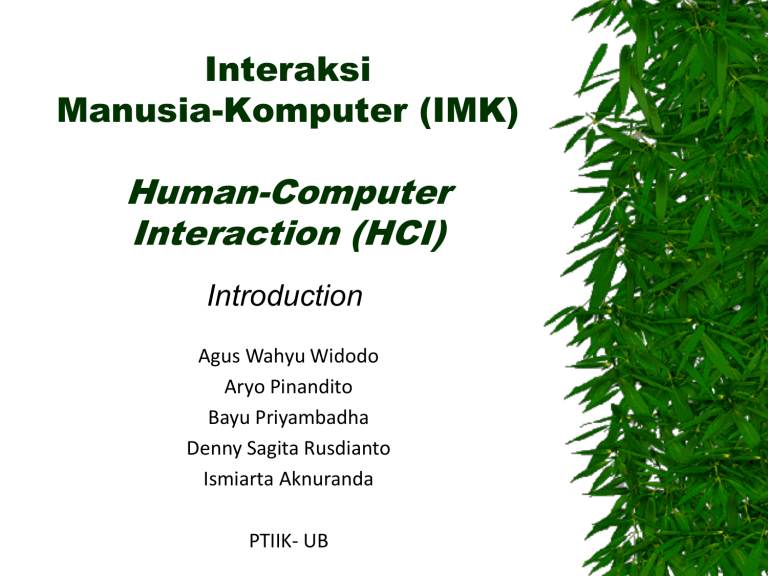
Interaksi
Manusia-Komputer (IMK)
Human-Computer
Interaction (HCI)
Introduction
Agus Wahyu Widodo
Aryo Pinandito
Bayu Priyambadha
Denny Sagita Rusdianto
Ismiarta Aknuranda
PTIIK- UB
Description
Name: Interaksi Manusia - Komputer
Code: PTI 15005
Semester: 2
Credits: 5 sks
Status: Compulsory
Pre-requisite: -
Introduction - PTIIK UB 2012
Automatic Syringe
Setting the dose to 1372
Introduction - PTIIK UB 2012
Automatic Syringe
Introduction - PTIIK UB 2012
Why HCI?
The interface should not just present a ‘pretty face’, but should support the tasks that people actually want to do, and forgive the careless mistakes.
It is not at all intuitive or easy to design consistent, robust systems that will cope with all manner of user carelessness
The interface is not something that can be plugged in at the last minute; its design should be developed integrally with the rest of the system.
Introduction - PTIIK UB 2012
Why HCI?
Part of law in developed countries, e.g.:
– National health and safety standards constrain employers to provide their workforce with usable computer systems: not just safe but usable.
Introduction - PTIIK UB 2012
Why HCI?
Part of law in developed countries, e.g.:
– EC Directive 90/270/EEC requires employers to ensure the following when designing, selecting, commissioning or modifying software:
that it is suitable for the task
that it is easy to use and, where appropriate, adaptable to the user’s knowledge and experience
that it provides feedback on performance
that it displays information in a format and at a pace that is adapted to the user
that it conforms to the ‘principles of software ergonomics’.
Introduction - PTIIK UB 2012
Ergonomics or Human Factors
The International Ergonomics Association:
Ergonomics (or human factors) is the scientific discipline concerned with the understanding of interactions among humans and other elements of a system, and the profession that applies theory, principles, data and methods to design in order to optimize human well-being and overall system performance.
Introduction - PTIIK UB 2012
Brief history of HCI
Has only been in widespread use since the early 1980s
But has its roots in more established disciplines
Systematic study of human performance in factories, emphasis on manual tasks, the early 1900s
Study of interaction between human and machines,
World War II (1939-1945), for more effective weapon systems
After WWII, the Ergonomics Research Society, 1949
Ergonomics Human Factors
Man-machine interaction
Human-computer interaction
Introduction - PTIIK UB 2012
HCI Main Components
The human:
– an individual user,
– a group of users working together, or
– a sequence of users in an organization,
– each dealing with some part of the task or process
The computer:
– any technology ranging from the general desktop computer to a large-scale computer system, a process control system or an embedded system.
The interaction:
– any communication between a user and computer, be it direct or indirect.
– The important thing is that the user is interacting with the
Triple ‘Use’-s
Useful – accomplish what is required: play music, cook dinner, format a document;
Usable – do it easily and naturally, without danger of error, etc.;
Used – make people want to use it, be attractive, engaging, fun, etc.
Introduction - PTIIK UB 2012
Learning Objectives
Understand the characteristics of the fundamental components of an interactive system:
– the human user,
– the computer system
– the nature of the interactive process
Understand the design process of an interactive system
Apply appropriate principles, models, and techniques of user interface design and evaluation
Introduction - PTIIK UB 2012
Main Topics
Foundations
– The human
– The computer
– The interaction
– Paradigms
Design Process
– Interaction design basics
– HCI in the software process 225
– Design rules
– Implementation support
– Evaluation techniques
Introduction - PTIIK UB 2012
Main Topics
Models and Theories
– Cognitive models
– Socio-organizational issues and stakeholder requirements
– Communication and collaboration models
– Task analysis
– Dialog notations and design
– Models of the system
– Modeling rich interaction
Introduction - PTIIK UB 2012
References
Dix , A.J., et al. 2004. Human-Computer Interaction,
Third Edition, Prentice Hall, USA.
Ariyus, D. 2007. Interaksi Manusia dan Komputer, Andi
Publisher, 2007.
Santosa, I. 2010. Interaksi Manusia dan Komputer Edisi
2, Andi Publisher.
Shneiderman, B. and Plaisant, C. 2010. Designing the
User Interface, 5th Edition. Addison Wesley.
Introduction - PTIIK UB 2012
Other Supports
Moodle:
– Old: http://elearning.ptiik.ub.ac.id
– New: under setup
Blog:
http://iaknuranda.lecture.ub.ac.id
Class representative
Please have one soon
Introduction - PTIIK UB 2012
Assessment
Project: 25-30%
Assignments: 10-15%
Mid-exam (UTS): 25%
Final exam (UAS): 35%
Introduction - PTIIK UB 2012
Learning Principles
Spirituality on Learning
– Positive attitude
– Learning is not a choice, but a natural obligation
– Pray for beneficial knowledge
– Prepare yourself for knowledge…
– ..because knowledge is light and it only comes to those who are ready
Community of learners
– All of us are learners
– Everyone should be self-directed, active, and critical
– Unlimited learning resources
Introduction - PTIIK UB 2012
Have a nice journey of learning!
Introduction - PTIIK UB 2012





